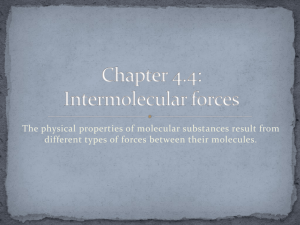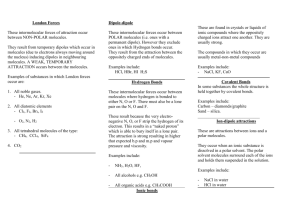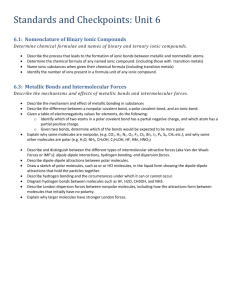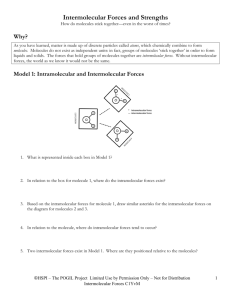Intermolecular Forces: Types, Strength & Examples
advertisement
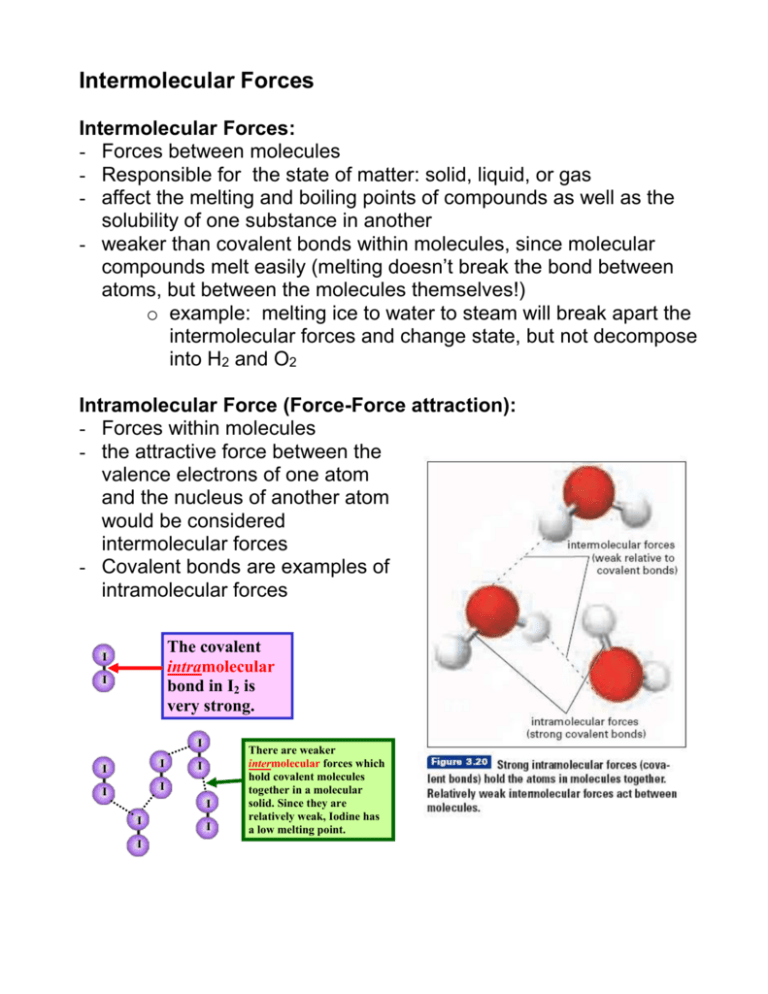
Intermolecular Forces Intermolecular Forces: - Forces between molecules - Responsible for the state of matter: solid, liquid, or gas - affect the melting and boiling points of compounds as well as the solubility of one substance in another - weaker than covalent bonds within molecules, since molecular compounds melt easily (melting doesn’t break the bond between atoms, but between the molecules themselves!) o example: melting ice to water to steam will break apart the intermolecular forces and change state, but not decompose into H2 and O2 Intramolecular Force (Force-Force attraction): - Forces within molecules - the attractive force between the valence electrons of one atom and the nucleus of another atom would be considered intermolecular forces - Covalent bonds are examples of intramolecular forces The covalent intramolecular bond in I2 is very strong. I I I I I I I I I I I I There are weaker intermolecular forces which hold covalent molecules together in a molecular solid. Since they are relatively weak, Iodine has a low melting point. TYPES OF FORCES Type of Force London Forces (Vanderwal forces) Exists between Explanation - all molecules, but especially important in non polar covalent molecules Dipoledipole - polar covalent molecules - results from the random movement of the electrons in the molecule which generates temporary positive and negative regions in the molecule. - very weak - strength increases with atomic number - the only type of intermolecular force operating between non-polar molecules (e.g. H2, CO2) - attraction between opposite dipoles on two molecules in a compound - stronger than London forces but weaker than hydrogen bonding - causes an increase in mp and bp relative to non polar molecules (e.g. PCl3,CH3Cl) - interaction of a non-bonding pair of electrons with a hydrogen which is attached to an electronegative element such as oxygen - found in water and results in water having a higher mp and bp than other molecules of the same type - Hydrogen bonds are about five times stronger than regular dipole-dipole bonds - It occurs when N, O, or F are bonded to H. -large EN value - about one-tenth the strength of a covalent bond (e.g. H2O, NH3) - the dipole is attracted to the oppositely charged ion + – + – + – – + Hydrogen bond - polar covalent molecules Dipole-Ion - between an ion and one end of a polar molecule (eg in dissolving of ionic compounds in water) What kind(s) of intermolecular forces are present in the following substances: a) NH3, b) SF6, c) PCl3, d) LiCl, e) HBr, f) CO2 (hint: consider EN and molecular shape/polarity) a) NH3: Hydrogen bonding (H + N), London. b) SF6: London only (it is symmetrical). c) PCl3: EN=2.9-2.1. Dipole-dipole, London. e) HBr: EN=2.8-2.1. Dipole-dipole, London. d) LiCl: EN=2.9-1.0. Ionic, (London). f) CO2: London only (it is symmetrical) London forces Instantaneous dipole: Induced dipole: Eventually electrons A dipole forms in one atom are situated so that or molecule, inducing a tiny dipoles form dipole in the other Why oil and water don’t mix + + – + + + – + – + + – + + + – – + + The non-polar substance is pushed away. If it were moving faster it might break + – + through the attractive forces. Solubility is a balance be+ – + tween speed and attraction. Also, the more similar the strength of their dipoles the more likely two compounds are to mix. + –


